![]()
![]()
![]()
Use LEFT and RIGHT arrow keys to navigate between flashcards;
Use UP and DOWN arrow keys to flip the card;
H to show hint;
A reads text to speech;
70 Cards in this Set
- Front
- Back
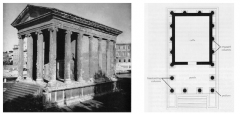
|
Temple of Portunus
Rome 80-70 bce. Late Republican (Roman Classicism) • Italic type • orientation rather than peripheral, raised on podium, accessible from just one side • Ionic order • during a time when Romans were adopting Greek culture, "Hellenized Roman" type • small temple • Romans were very suspicious. Religion was less about personal salvation and more about the future of the state. Kept up their temples and sacrificed animals. Had lots of different temples because they were polytheists. |
|
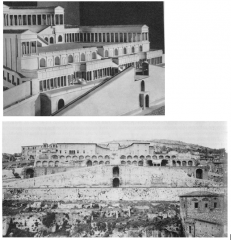
|
Sanctuary of Fortuna Primigenia.
Praeneste (Palestrina) last 2nd century bce Late Republican (Roman Classicism) • hillside sanctuary, also oracle there • fortune goddess was very important to the Romans • broadening of upper staircase into theatre • organic planning • dual functioning building • use of concrete, cement |
|
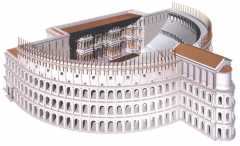
|
Theater complex of Pompey
Rome dedicated in 55 bce Late Republican (Roman Classicism) • Rome's first permanent theatre, also held shrines dedicated to Venus and art pieces • Resembles Greek theatre in form, has caveas & orchestra • elaborate back-drop • organic planning • cement faced with marble used, not constructed like a Greek temple which had blocks resting on each other • has a temple dedicated to Venus, the seats serve as the staircase leading to the temple • artificial slope made out of concrete allowed architects to build the theatre independent of the landscape |
|
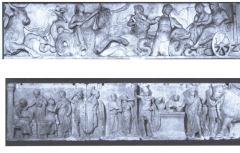
|
Sculptural relics from statue base
late 2nd to early 1st century bce Late Republican (Roman Classicism) marble • sea thiasos and census depictions • both from same monument, but very different styles. Swirling shapes of mythological scene contrast with the static figures of the census scene • top: mythological, baroque/Hellenistic • bottom: political and depicting actual events, sacrifice & census, not found in Greek art • art without provenance • Romans thought that the gods did interact with them, but less directly than the Greeks thought, who always depicted the gods in human form, etc. Romans more superstitious • census: your wealth was declared and registered there, state was vested in increasing population |
|
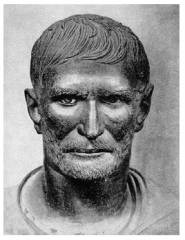
|
Brutus of the Capitoline
late 4th, early 3rd century bce Late Republican (Roman Classicism) bronze • not just a work of art, big part of Roman culture • identification is iffy • Greek art was hostile to the notion of portaiture, but Romans used it often (ex- on their coins) to revere people, usually military people • has his eyes and looks back at us. For Romans, it looking at you was more important than you looking at it • creases and furrows reveal a life of engagement and reflection, an image marked by age conveyed the necessary qualities for holding office |
|
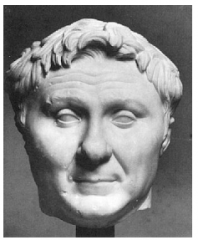
|
Pompey
marble 50 bce Late Republican style (Roman Classicism) • Rival of Caesar • surface level is preserved • he looks silly, clearly not idealized, but his hair part is mimicked after Alexander the Great, was originally meant to look like a lion mane (zoomorphism), regal affectation • veristic, shows little gravitas |
|
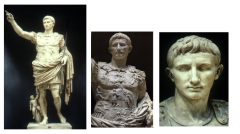
|
Augustus of Primaporta
20 ce marble Augustan style (Roman Classicism) • Only 36 when he became emperor, so veristic portrait with its stress on maturity did not fit him. Instead turned to a more Hellenizing style • adopted son of Caesar, originally Octavian, took power after Caesar was murdered • Probably addressing army rather than citizens because he is wearing military attire • barefoot => divine • dolphin suggests Isles of the Blessed where he prevailed over Marc Antony, Cupid refers to his claim that he is descendent of goddess of love Venus • Based on Polykleitos' "Dorypherous": contrapposto, use of Classical Greek culture to suggest nobility and elitism to mask the fact that he was a tyrant, imitation • but still very much Roman- breast piece has a cosmic feel, shows complicated story (Apollo on griffin, Chariot of the sun, Diana/Artemis on stag, west represents province of Spain, East depicts barbarian, center shows Roman soldier with a dog receiving a standard (illusion to diplomatic victory over Persians)) • combo of Greek idealism (he is shown as of no certain age, doesn't look too much like he did in real life) and Roman verism (distinctive features, obviously Augustus) • expresses a message by referencing earlier works • not propaganda, but definitely meant to paint him in a positive light, gives him earthly as well as divine power |
|
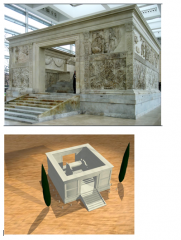
|
Altar of Augustan Peace
Rome 13-9 bce Augustan style (Roman Classicism) • open to the sky • Augustus "found Rome as a city of bricks, left it a city of marble." He restored the worshipping of the ancient gods & customs, population increased under his reign, but he was a tyrant and reestablished monarchy. • screen wall around altar, looks like enclosure supported by piers, supporting entablature |
|
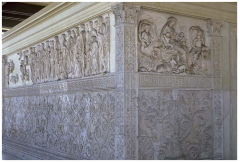
|
wall relief from Altar of Augustan Peace
Rome marble 13-9 bce Augustan style (Roman Classicism) • meander pattern • below: plant design populated with small creatures (ex- lizards), shows flourishing of nature & rich abundance under Augustus • above: historical/ allegorical context flank: allegory, image of Peace |
|
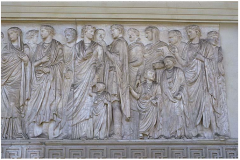
|
wall relief from Altar of Augustan Peace
Rome marble 13-9 bce Augustan style (Roman Classicism) • Members of imperial family of Augustus interspersed with priests & senators • everyone is personalized and recognizable • Inclusion of women (Livia) and children (Romans liked depicting children) |
|
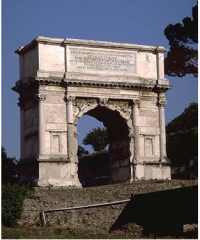
|
Arch of Titus.
Rome 81 ce Trajan/Hadrian style (Roman Classicism) • notion of a monument dedicated to a triumph as a commemoration is very Roman • dedicated to emperor Titus for his triumph over Jerusalem • Corinthian order columns carved |
|

|
Triumph & Procession with Spoils of Temple
from Arch of Titus, Rome 81 ce Trajan/Hadrian style (Roman Classicism) •apotropaic device • Sack of Jerusalem is controversial (this portrays destruction of 2nd temple in Jerusalem), this is a difficult monument for many people • Romans carrying a candelabrum, ahead of them are Romans carrying polls going under oblique arch • action is diagonal to plain of relief • completely historical, not mythological • "Flavian Baroque" |
|
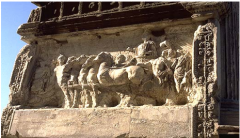
|
Triumphal Procession: emperor in chariot crowned by victory & preceded by Honor and Virtue
from Arch of Titus 81 ce Trajan/Hadrian style (Roman Classicism) • depiction of actual triumph over Jerusalem • Honor and virtue are personified, older bearded man represents the Senate, the half-naked person represents the Roman people |
|

|
Column of Trajan
Rome 106-113 ce Trajan/Hadrian style (Roman Classicism) • Originally, spiral staircase existed inside (belvedere) • Trajan as protagonist- great military figure and emperor. Extended Rome's boundaries and turned it into an empire rather than just a city • very extensively sculpted, shows every single event of the campaign against the Udacians. Individual scenes are not distinctly separate. Trees & buildings placed to suggest divisions, but it is all a unified piece • detail: Trajan's army crossing the Danube, the river being personified by a man |
|
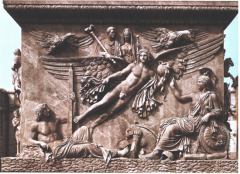
|
column base of Antonius Prius and Faustina.
161 ce marble Antonine style (Late Antique) • from base of a large column • less naturalistic, more linear treatment of the body. Classical proportions & idealized faces in apotheosis scene, but on other sides of base, proportions are stalky, squat. • Antonius Pius was an excellent emperor, Faustina was his wife • The couple depicted ascending into Heaven with Rome (personified as a woman) as a witness • Winged man perhaps personifying the act of ascension, or a genius of time |
|
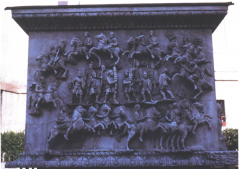
|
Cavalrymen riding around a group of soldiers golding standards
161 ce marble Antonine style (Late Antique) • other side of base of large column • funerary ritual for Antonius Pius and Faustina |
|
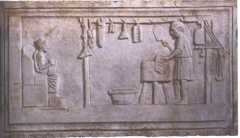
|
Funerary Relief of a Butcher & Woman
151 ce marble Antonine style (Late Antique) • flat quality to it, stalky body proportions • private monument from a tomb • presumably husband and wife • husband is the butcher/ laborer, and the wife is the accountant/writer (typology) • happy couple, division of labor |
|
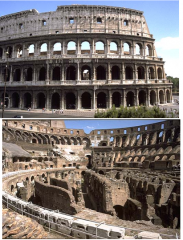
|
Colosseum
Rome 72-80 ce Trajan/Hadrian style (Roman Classicism) • limestone, concrete faced with travertine • Facadism • icon of Rome • built by Vespasian as a "pleasure garden" for himself, where he held shows, gladiator fights, exotic animals • 80 separate entrances • sequence of orders: doric, ionic, corinthian orders lie above the other • Interior of colosseum: remains of cages, elevators • extremely stable |
|

|
The Pantheon.
Rome. 117-125. Agrippa, architect. Trajan/Hadrian / Antonine style (Roman Classicism/Late Antique) • One of the best preserved temples of Rome • "Facadism"- colored marble on walls, floor colored in squares/circles, but actual structure is concealed somewhat • light comes in through oculus at top of dome, makes you feel sheltered and exposed at the same time • organic unity • survives today as a church, well preserved • "Agrippa" inscription preserved on exterior, was the architect. • coffered |
|
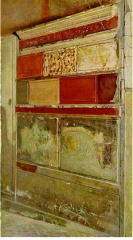
|
"First Style" Wall painting in Samnite House
Herculaneum. Late 2nd century bce Late Republican Style (Roman Classicism) fresco • "First Style" ("Incrustation Style") - imitating colored marble using paint & stucco • from plaster wall, colored & spattered fresco technique to color blocks • cornice with drafted molding |
|
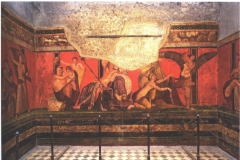
|
"Second Style" ("architectural style") Wall painting in Villa of the Mysteries
60-50 bce Late Republican Style (Roman Classicism) • "Second Style" (Architectural Style) - incorporating architectural features • give off a quiet power & vivid drama • resembles architecture but are actually paintings |
|
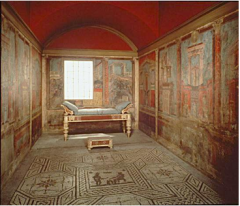
|
"Second Style" ("Architectural style") wall painting from Boscoreale - Taking architectural aspect to new level by suggesting existence of another world beyond the wall
50 bce Late Republican Style (Roman Classicism) • landscapes, cityscaped • 3-part architectural thing, doorways |
|

|
"Second style" ("Architectural style") Garden painting from Villa of Livia at Prima Porta
20 bce Augustan Style (Roman Classicism) • illustrates natural world, plant life (A Roman interest, not Greek) • its lushness beckons, but this fantasy world lies beyond our reach • atmospheric perspective- plant and animal life become less distinct as they recede into the background |
|
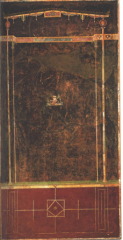
|
"Third Style" ("ornate style") wall painting, Boscotrecase
10 bce Augustan Style (Roman Classicism) • third style - abandoning illusionism in favor of solid planes in rich colors like black, red • tiny vignette in center of landscape • spindly, thin columns • beautiful brushwork • considered a luxurious artform |
|
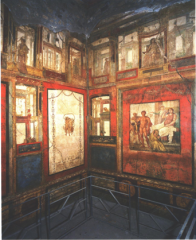
|
"Fourth style" ("intricate style") wall painting from House of the Vetii
63-79 Trajan/Hadrian Style (Roman Classicism) • Fourth Style - most intricate of all, uniting aspects of all the styles • lots of spatial depth, like you're looking into a space • large-framed compositions, often mythological • luxurious, meant for guests |
|
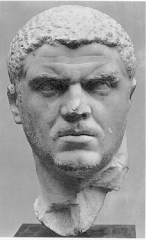
|
Portrait of Emperor Caracalla
211-217 Third-Century style (Late Antique) marble • cruel emperor, fierce, brooding expression • beginnings of militaristic portraiture, "philosopher look" is out. • veristic • disjoint between surface and mass - flabby cheeks, contracted brows, head is basketball-shaped • very short hair, scruff • function was to instill fear, suggest strength |
|
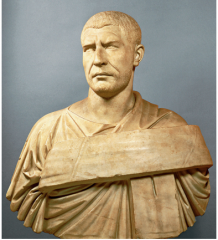
|
Portrait of Philip the Arab
244-249 bce Third-Century style (Late Antique) marble • cruel like Caracalla, similar portraits (more short hair, inflated head, brooding, veristic) • deep bust ("pedestal bust") • shown in toga and sash • skin appears leathery, surface tension • function was to instill fear, suggest strength |
|
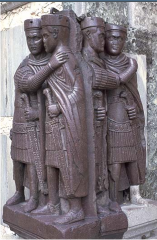
|
Portrait Group of the Tetrarchs
305 ce Constantinian Style (Late Antique) Porphyry • very abstract, symbolic features, not idealized • Porphyry was a blood-red/purple stone, very hard to work with • rounded, linear, exaggerated forms |
|
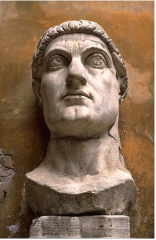
|
Constantine the Great
Marble head from statue 315 ce Constantinian Style (Late Antique) • was advised by a Christian counselor, was the first to recognize Christianity as a legitimate religion • is considered a Christian saint • "colossal head" - larger than lifesize • abstract feel, sharply delineated features, eyes turn upward as if looking to greater power, head is blown up |
|

|
Arch of Constantine
Rome 312-315 Constantinian Style (Late Antique) • triple triumphed arch • Corinthian columns • embellished by sculpture that Constantine took from other Roman monuments ("spolia") |
|

|
frieze form Arch of Constantine
312-315 Constantinian Style (Late Antique) • not a spolia, but shows Constantine giving out bread • not super beautiful, very late Antique style |
|

|
Baths of Caracala
Rome. 211-216 Third-Century style (Late Antique) • occupies large section of southern Rome • bathing: cold room, hot room, warm room. Also swimming pool, exercise courts, libraries, changing rooms, temples • Typical way of spending the afternoon • use of aqueducts |
|
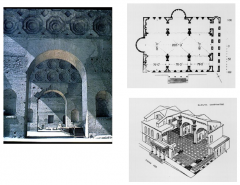
|
Basilica Constantine
4th century Constantinian Style (Late Antique) • this is the groundplan & photo with the 3 surviving arches • chambers still survive today • cetner axis has raised roof • groin vault |
|
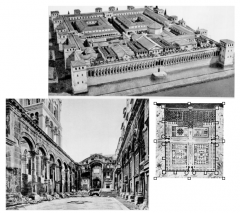
|
Palace of Emperor of Diocletian
Split, Croatia. 300 ce Constantinian style (Late Antique) • retirement palace of Diocletian with tomb • patterned on a military camp • mini town: has palace, forum, barracks for soldiers, etc • arches and columns stand together on an arcade (not customary, late change) |
|
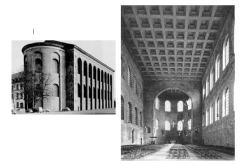
|
Basilica of Constantius Chlorus
Ther, Germany 300 Constantinian Style (Late Antique) • He was one of the tetrarchs & the father of Constantine • secular building as bank and court, was later turned into Christian church • concrete faced with brick • organic • beam ceiling, interior is not delicate |
|
|
apology
|
teaching through the use of images
|
|
|
narthex
|
transverse entrane hall of a church, sometimes closed but often open on one side to a preceding atrium, porch
|
|
|
choir
|
part of a church between the altar and the nave, used by clergy and choir
|
|
|
syncretism
|
Bringing diverse elements together to produce something entirely new with powerful message-bearing. A profoundly Roman attitude towards art.
|
|
|
Etrusco-Italic
|
A kind of Roman architecture that has Greek (rectilinear form, use of columns, gabled roof) as well as Roman/Etruscan influences (high podium, frontal access, arches, domes)
|
|
|
barrel vault
|
vault formed by a continuous semicircular arch, used by Egyptians Greeks and Romans alike
|
|
|
concrete
|
Mixture of mortar, aggregate (brick, limestone), and pozzolana sand. Extremely durable, easy to use, and inexpensive. Used often by Romans in architecture
|
|
|
basilica
|
In Rome: long, oblong building used as a public meeting place & hall of justice. Consisted of nave, side alies, and apses.
In Christian architecture: longitudinal church derived from Rome |
|
|
apse
|
semicircular niche terminating ends of a nave in a Roman/Christian basilica
|
|
|
nave
|
central aisle of a Roman/Christian basilica
|
|
|
annular (barrel vault)
|
ring-shaped barrel vaults found in Roman/Christian basilicas
|
|
|
classicizing
|
referring to the forms/ideas of the Greek/Roman classical world. A type of art treatment, especially sculpture (ie- in drapery, faces, and musculature)
|
|
|
liminal space
|
A transitional area, such as a doorway or archway. In Rome they were often decorated with apotropaic devices, and relief.
|
|
|
tesserae
|
small colored stones fitted together to create a pattern/ figural image. This type of mosaic used in Rome.
|
|
|
atmospheric perspective
|
creates the illusion of depth by making color less and less vibrant in background of a scene
|
|
|
composite capital
|
New style, Roman. An imperial phenomenon, architects used it as a substitute for the Ionic capital. Combined the volutes of the Ionic capital with the acanthus leaves of the Corinthian capital, the result being richly decorative.
|
|
|
Tuscan style
|
New building style, Roman. Resembled the Doric style but the shaft stoof on a base. Used throughout the Roman period.
|
|
|
dome
|
Vaulted roof of circular plan. Popularized in Rome, particularly in large temples
|
|
|
oculus
|
Hole in a dome roof open to the sky, allows natural light into the space. The slice of sunlight in the center of the cella points out where to go to visitors. Seen in Roman temples with dome roofs.
|
|
|
coffers
|
Recessed, geometrically shaped panels in a ceiling. Seen in Rome
|
|
|
belvedere
|
structure made for the purpose of viewing its surroundings
|
|
|
rotulus
|
scroll (Latin)
|
|
|
module
|
1 segment of a pattern
2 construction measure, basic unit of measurement |
|
|
encaustic
|
Roman painting technique, involves suspending pigments in hot wax. Durable.
|
|
|
domus
|
an elite Roman houseDetached, one-family house with rooms grouped around 2 courts: the Atrium was used for entertaining and conducting business and the Peristyle was for the private use of the family
|
|
|
impluvium
|
shallow pool in a Roman house (in Atrium) for collecting rainwater
|
|
|
cubicula
|
Roman bedroom grouped around Atrium
|
|
|
insula
|
poorer Roman's home, concrete-and-brick building around small central court
|
|
|
dado
|
lower part of an interior wall, often decorated with paintings imitating costly marbles (1st-4th styles)
|
|
|
trompe-l'oleil
|
"trick of the eye", painting technique used in Rome to deceive viewer into thinking that the art is reality
|
|
|
clerestory
|
row of windows in the upper part of a wall that rises above an adjoining roof, used to provide direct lighting such as in a basilica.
|
|
|
martyrium
|
a church or shrine built over the grave of a Christian martyr or at the site of an important miracle, the beginnings of religious martyrdom
|
|
|
arcuation
|
the use of arches or a series of arches in a building
|
|
|
spolia
|
1 spoils of war
2 fragments of architecture/ sculpture reused in a second context |
|
|
rostrum
|
platform/ stage used for public speaking in a Roman forum
|

